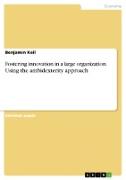- Start
- Fostering innovation in a large organization. Using the ambidexterity approach
Fostering innovation in a large organization. Using the ambidexterity approach
Angebote / Angebote:
Seminar paper from the year 2019 in the subject Business economics - Business Management, Corporate Governance, grade: 1, 0, TU Dortmund, course: Organization of Innovation, language: English, abstract: Successful organizations often have developed several core competencies in order to outstand competitors. In a stable environment it is high likely that organizations only focus on further improving and developing the core competencies that help them to get into this comfortable situation. With this approach one could remain the market leader in such a relatively stable environment. This might have been the case in the past, but it is not the way we see the environment in the last centuries. The competitive business environment has fundamentally changed. With the globalization of markets, rapid technological change, shortening of product life cycles, and increasing aggressiveness of competitors, organizations have to face these changes (Volberda, 1996). It is not sufficient to only improve competencies one is already good at. Organizations must also explore in emerging business fields, test new products and experiment new procedures. Organizing a company in a way so that some employees are working on exploitation and others on exploration at the same is therefore a challenging balancing act. The approach of managing this balancing act of exploration and ex- ploitation is called organizational ambidexterity (O'Reilly & Tushman, 2004). This seminar paper will deal with this concept and answers the following question: How organizations use ambidextrous design to ensure innovation?First, the concept organizational ambidexterity will be defined, and its five different literature streams presented. In addition to that, characteristics for organizations succeeding at this approach and possible implementation strategies will be discussed. Afterwards the methodological approach for the case study will be explained. The case study itself with a short company presentation of the Dr. Ing. h.c. F. Porsche AG and its findings cover chapter four. The conclusion in the last part will discuss the findings and give an overall summary with answering the research question.
Folgt in ca. 10 Arbeitstagen
